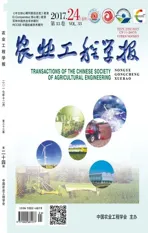生物降解秧盘及播种量对机插水稻秧苗素质及产量的影响
2018-01-09史鸿志朱德峰张玉屏张义凯朱从桦陈惠哲
史鸿志,朱德峰,张玉屏,向 镜,张义凯,朱从桦,武 辉,陈惠哲
生物降解秧盘及播种量对机插水稻秧苗素质及产量的影响
史鸿志,朱德峰,张玉屏,向 镜,张义凯,朱从桦,武 辉,陈惠哲※
(中国水稻研究所/水稻生物学国家重点实验室,杭州 310006)
为探明生物降解秧盘稀播育秧、带盘机插的生产适用性,以籼型杂交稻中浙优8号和籼粳型杂交稻甬优538为材料,普通平盘作对照,研究了生物降解秧盘不同播种量(30,50,70和90 g/盘)育秧对机插水稻秧苗素质、机插特性与产量的影响。结果表明,生物降解秧盘育秧显著提高出苗率(<0.05),且播种量越低,出苗率越高,中浙优8号30 g/盘处理的出苗率较普通平盘育秧高20.57个百分点。生物降解秧盘采用上毯下钵设计,所育秧苗根系独立成钵状,白根多且粗壮,其平均根直径较普通平盘宽8.63%,且盘根力均大于100 N,满足机插对秧块成毯的要求。同时,可带盘按钵精准机插,中浙优8号30 g/盘处理的漏秧率仅7.78%,较普通平盘机插低6.67个百分点。生物降解秧盘处理结实率和千粒重略低于普通平盘,群体颖花量则高于后者,最终产量较普通平盘机插略高。综合育秧、机插效果及产量表现,生物降解秧盘育秧播种量以70 g/盘为宜。因此,生物降解秧盘带盘机插可发挥稀播培育壮秧优势,提高机插质量,有助于杂交稻少本稀植、充分发挥增产潜力。
农作物;机械化;播种;水稻;机插;生物降解秧盘;秧苗素质;产量
0 引 言
随着农村劳动力转移和老龄化,中国水稻生产正逐步向轻简化、机械化作业转型[1-3]。提高水稻生产机械化水平,实现全程机械化,是当前中国水稻生产技术变革的关键。目前中国水稻生产综合机械化水平较低,种植机械化是其中的“瓶颈”环节[4-6]。机插秧以培育标准化壮秧与机械精确移栽,并配套高产高效农艺,相对更符合国情,是多数稻区种植机械化的基本方向[7]。
机插秧包括育秧和机插2个关键环节,其中育秧为保证秧块成毯和降低漏秧率,播种密度极大,苗间竞争激烈,导致所育秧苗素质较差[7-8]。因秧苗较弱,机插每穴本数又过多,不利于杂交稻壮秆大穗优势的发挥,使得杂交稻机插难以高产稳产[7]。此外,由于杂交稻制种产量低,其种子价格是常规稻种子的5~10倍,导致育秧成本较高[9]。在中国,杂交稻种植面积占到了水稻总种植面积50%~60%,实现杂交稻机插意义重大[10-11]。已有研究表明,降低播种量虽可显著提高秧苗素质,但低播量下秧块成毯性差,机插漏秧率高,大田基本苗不足,不利于实现高产[9,12-17]。低播量下如何保证秧块成毯、降低漏秧率,从而培育壮秧,实现杂交稻少本稀植,已成为杂交稻机插中亟待解决的问题。中国水稻研究所和河南青源天仁生物技术公司开展产学研合作,以聚乳酸(PLA)生物基塑料为原料,结合上毯下钵设计,研制开发了生物降解秧盘,通过培育壮秧,带盘机插,为杂交稻稀播机插提供了一种新的思路。本研究采用生物降解秧盘育秧,设置不同播种量,以普通平盘为对照,研究生物降解秧盘的农艺适用性,以期为杂交稻机插提供参考。
1 材料与方法
1.1 试验地点及供试材料
试验于2016年在中国水稻研究所富阳试验基地(30°5′N,119°55′E)进行。该区位于长江三角洲南翼,属中纬度亚热带季风性气候区,年平均温度16.1 ℃,无霜期为230 d,年日照时数为1 995 h,年平均降水量为1 501 mm。试验地土质为黏性水稻土,冬闲。0~20 cm土层有机质含量为27.2 g/kg,碱解氮232.7 mg/kg,速效磷20.5 mg/kg,速效钾136.9 mg/kg。
供试品种为籼型杂交稻中浙优8号和籼粳型杂交稻甬优538,中浙优8号由中国水稻研究所提供,甬优538由宁波种子公司提供。生物降解秧盘由河南青源天仁生物技术公司提供,规格为58 cm×28 cm×2.8 cm(长×宽×高),每盘648个钵穴。普通平盘采用市售大小一致的塑料硬盘。
1.2 试验设计
设置2种秧盘类型,分别为生物降解秧盘和普通平盘,记为BS和CS。播种量设置4个水平,分别为30、50、70和90 g/盘(以干种子质量计),记为D30、D50、D70和D90。育秧时每处理播9盘,随机排列,2品种合计144盘。采用常规泥浆育秧,5月25日播种,秧龄为19天,6月13日机插。机插时生物降解秧盘带盘机插,普通平盘取秧块机插。大田采用裂区设计,其中秧盘类型为主区,播种量为副区,小区面积为30 m2,3次重复,行株距为30 cm×18 cm,大田四周地膜包梗,排灌分开。试验氮肥(纯氮)施入量为180 kg/hm2,按基肥、蘖肥、穗肥=5∶3∶2分别施入。磷肥施过磷酸钙450 kg/hm2,一次性作为基肥施入。钾肥施氯化钾112.5 kg/hm2,一次性作穗肥施入。分蘖肥在机插后第7 d施入,穗肥在倒4叶叶龄期施入。苗期浅水勤灌,分蘖末期排水晒田,坚持多次轻晒的原则。拔节到成熟期采用湿润灌溉,干湿交替。其他管理措施统一按高产栽培要求实施。
1.3 测定项目与方法
1.3.1 出苗率
在播种后第9天每处理调查出苗数,采用专门的查苗器(尺寸15 cm×6 cm),计数查苗器内的秧苗。出苗率=出苗数/种子数×100%。
1.3.2 秧苗形态
在移栽前1天,每处理切取8 cm×8 cm秧块,洗净后选取有代表性秧苗30株,测定其株高、叶龄、茎基宽和叶面积;并分为地上部和根系,105 ℃杀青30分钟,80 ℃烘干至恒质量,称其质量。其中,秧苗重高比=秧苗地上部干质量/秧苗株高。
1.3.3 秧苗根系特征
在移栽前1天,每处理选取代表性秧苗3株,使用扫描仪(Epson V700,China)对秧苗根系进行数字化扫描,再使用与扫描仪配套的根系分析系统软件WinRHIZO PRO 2013(Regent Instrument Inc., Canada)分析根系特征参数。3次重复。
1.3.4 盘根力
在移栽前1天,取标准秧块(58 cm×28 cm),一端固定,另一端用夹板夹紧后,用数显拉力计水平向外拉秧块,秧块断裂时的拉力即为盘根力(单位:牛顿)。并对秧块成毯效果进行评价,秧块不能成毯记为差,勉强成毯记为一般,秧块抖动不散、成毯效果好记为良。
1.3.5 机插漏秧率
机插第2天,每小区随机选取3行,每行30丛,调查每丛机插苗数和漏插丛数。其中,漏插指机插后插穴内无秧苗。漏秧率=漏插丛数/调查总丛数×100%。
1.3.6 产量及其构成
在成熟期每小区调查60穴,计算有效穗数,并实收核产。取代表性3穴调查每穗粒数、结实率和千粒质量。
1.4 数据计算与统计分析
数据统计分析采用Microsoft Excel 2016和DPS 7.05软件;Duncan新复极差法进行差异显著性检验;Origin 2017软件制图。
2 结果与分析
2.1 生物降解秧盘育秧对出苗率的影响
由图1所示,除中浙优8号普通平盘育秧外,出苗率随播量减少均呈显著增加趋势(<0.05),其中以生物降解秧盘30 g/盘处理出苗率最高,中浙优8号和甬优538分别达到了91.08%和87.76%。播量为30和50 g/盘时,随播量增加,中浙优8号中生物降解秧盘出苗率下降11.64个百分点,普通平盘下降10.22个百分点,甬优538则分别下降了8.53个百分点和17.6个百分点。2种秧盘比较,中浙优8号生物降解秧盘30和50 g/盘处理的出苗率显著高于普通平盘(<0.05),分别高20.57个百分点和19.15个百分点,而甬优538两种秧盘差异不显著(>0.05)。播量为70和90 g/盘时,随播量增加出苗率下降不显著,2种秧盘间差异也不显著,中浙优8号出苗率在58.96%~64.64%间,甬优538出苗率在61.24%~67.49%间。可见,稀播条件下(特指30 g/盘,下同)生物降解秧盘育秧有利于提高出苗率。
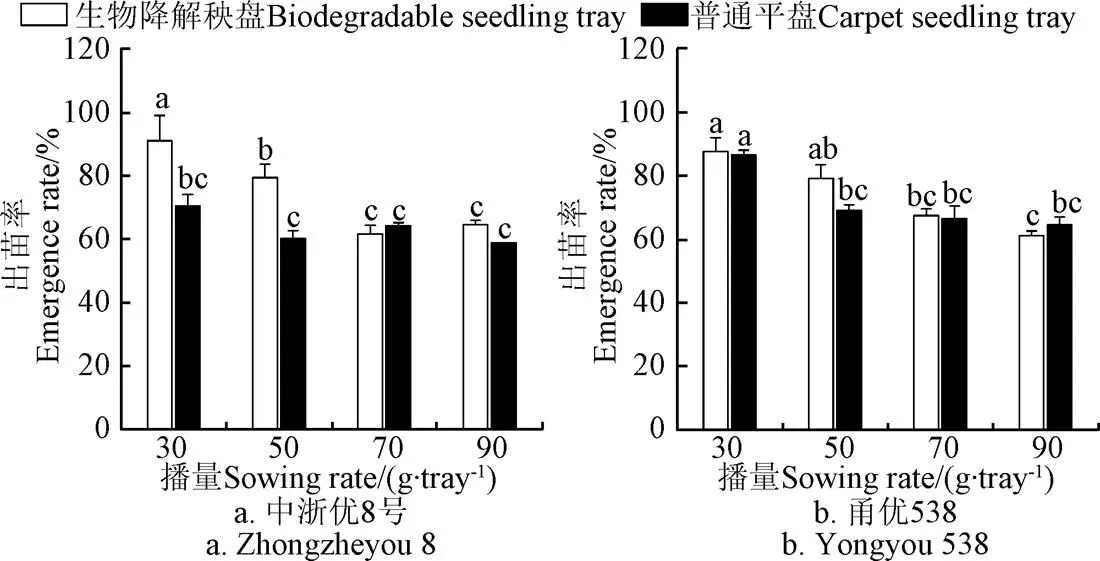
注:不同小写字母表示不同处理间差异达到5%显著水平。
2.2 生物降解秧盘育秧对秧苗素质的影响
2.2.1 秧苗形态
由表1可知,随播量增加,秧苗株高、叶龄、茎基宽、叶面积、根数、地上部干质量、根干质量和重高比总体上呈降低趋势。以生物降解秧盘为例,中浙优8号90 g/盘处理的茎基宽、叶面积、根数、地上部干质量、根干质量和重高比较30 g/盘处理分别下降21%、25%、17%、36%、24%和37%,甬优538中则分别下降16%、40%、32%、32%、25%和14%。不同秧盘间,生物降解秧盘所育秧苗的平均株高显著高于普通平盘,而平均根数和平均根干质量则表现出低于普通平盘的趋势,除中浙优8号中根数差异极显著外,其他差异都不显著(>0.05)。茎基宽差异不显著(>0.05),叶龄、叶面积、地上部干质量和重高比在2品种中表现不一。稀播条件下,中浙优8号中生物降解秧盘所育秧苗的株高、茎基宽、地上部干质量、根干质量和重高比显著高于普通平盘(<0.05),甬优538中生物降解秧盘所育秧苗的株高显著高于普通平盘,而根干质量和重高比显著低于普通平盘(<0.05)。可见,稀播有利于优化秧苗形态,生物降解秧盘所育秧苗形态与普通平盘无显著差异,中浙优8号在稀播条件下使用生物降解秧盘育秧优于使用普通平盘。
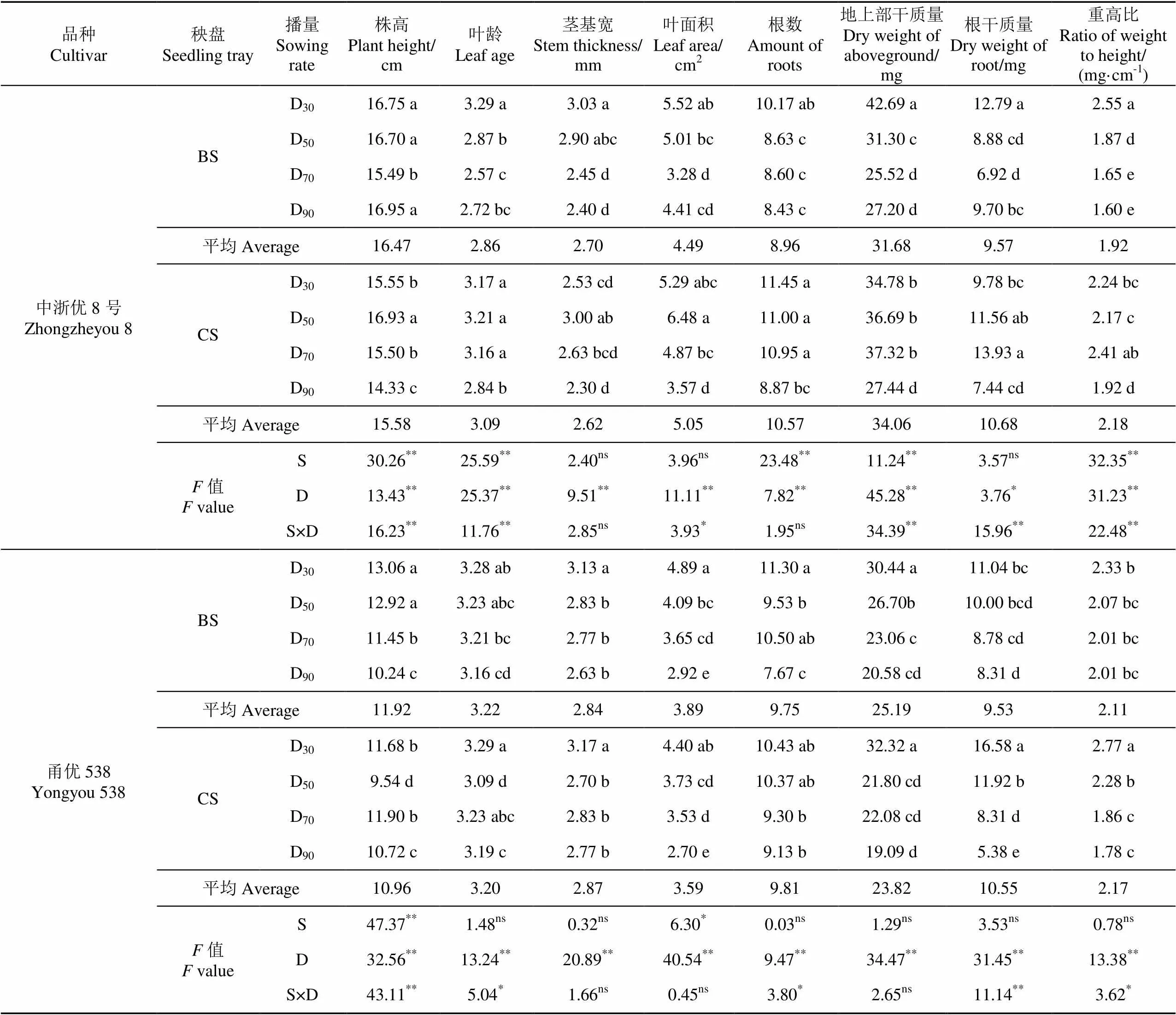
表1 不同秧盘和播量育秧的秧苗形态
注:BS表示生物降解秧盘;CS表示普通平盘;D30、D50、D70和D90分别表示播量30、50、70和90 g/盘;S表示秧盘;D表示播量;同列不同小写字母表示相同品种中不同处理间差异达到5%显著水平;*和**分别表示在0.05和0.01水平上差异显著。ns表示在0.05水平上差异不显著,下同。
Note: BS means biodegradable seedling tray. CS means carpet seedling tray. D30, D50, D70and D90mean that the sowing rates are 30, 50, 70 and 90 g/tray, respectively. S means seedling tray. D means sowing rate. Different lowercase letters in a column indicate significant difference at 0.05 level among different treatments in the same cultivar.*and**mean significant differences at 0.05 and 0.01 probability levels, respectively. ns means no significant differences at 0.05 levels, the same as below.
2.2.2 秧苗根系特征
由表2可知,随着播量增加,秧苗根长度、根表面积和根体积均呈显著下降趋势,根直径变化不明显。以生物降解秧盘为例,中浙优8号90 g/盘处理的根长度、根表面积和根体积分别较30 g/盘处理减少了27%、35%和48%,甬优538中则分别减少了57%、58%和59%,秧苗根系生物量显著减少。不同秧盘间,生物降解秧盘所育秧苗的平均根长度、根表面积和根体积均低于普通平盘,甬优538中差异极显著,而中浙优8号中差异不显著。就平均根直径而言,生物降解秧盘显著高于普通平盘,平均比普通平盘宽8.63%,中浙优8号中生物降解秧盘处理的平均根直径较普通平盘宽9.03%,甬优538同比宽8.23%。试验中发现生物降解秧盘所育秧苗的根系独立成钵状,白根多,而普通平盘所育秧苗的根系盘结交错,根黄,老根多(见图2)。可见,稀播有利于增加秧苗根系生物量,扩大根系的营养吸收面积;生物降解秧盘所育秧苗根系相对独立、短粗、根白,吸收营养物质的能力相对较强。
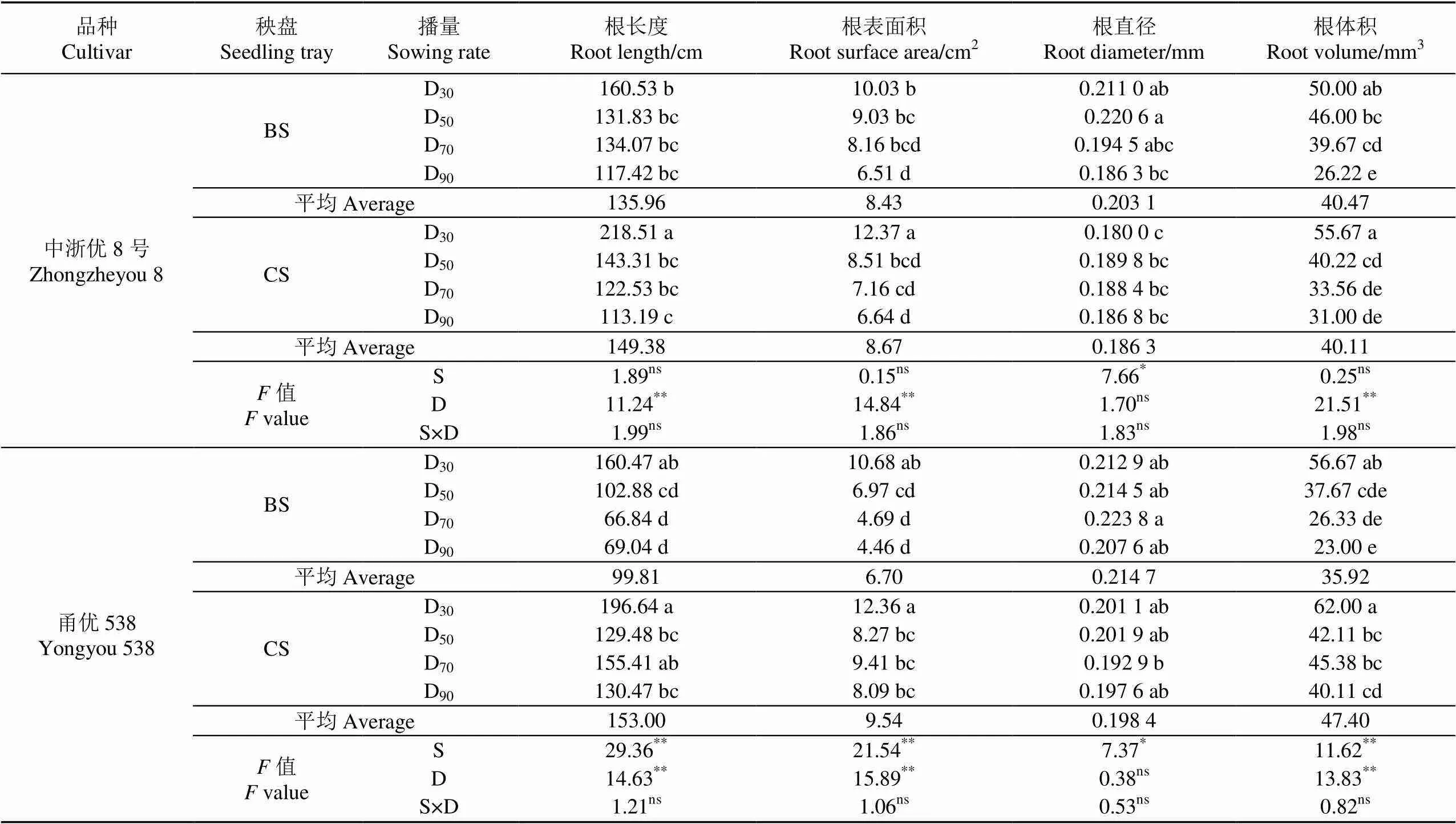
表2 不同秧盘和播量育秧的秧苗根系特征

图2 不同秧盘育秧秧苗根系比较(甬优538,70 g/盘)
2.3 生物降解秧盘的机插特性
2.3.1 盘根力
由表3可知,供试品种在生物降解秧盘育秧的条件下,各播量处理盘根力都超过了100 N,满足起秧、运秧和装秧过程中对秧块结构性的要求。而普通平盘在稀播条件下成毯性差,几乎不能起秧,中浙优8号在70 g/盘、甬优538在50 g/盘以上时成毯才能满足机插要求。

表3 不同秧盘和播量育秧的盘根力
2.3.2 漏秧率
随播量增加,2种秧盘育秧的机插漏秧率均呈下降趋势(图3)。30 g/盘播量处理机插漏秧率最高,中浙优8号中生物降解秧盘和普通平盘的机插漏秧率分别达到了7.78%和14.44%,甬优538中也分别达到了18.33%和15.56%,均超过5%的机插漏秧率要求上限[8]。当播量达到90 g/盘时,各处理的机插漏秧率都控制在5%以内。不同秧盘间,2品种表现略有不同。中浙优8号中,除90 g/盘时2种秧盘差异不大外,30、50和70 g/盘生物降解秧盘的机插漏秧率分别比普通平盘低6.67、3.17和1.11个百分点。甬优538中,生物降解秧盘处理的机插漏秧率高于普通平盘处理,除70 g/盘外差异并不明显。以上结果表明,稀播条件下,机插漏秧率普遍超过5%,中浙优8号中生物降解秧盘机插较普通平盘机插漏秧率显著降低。
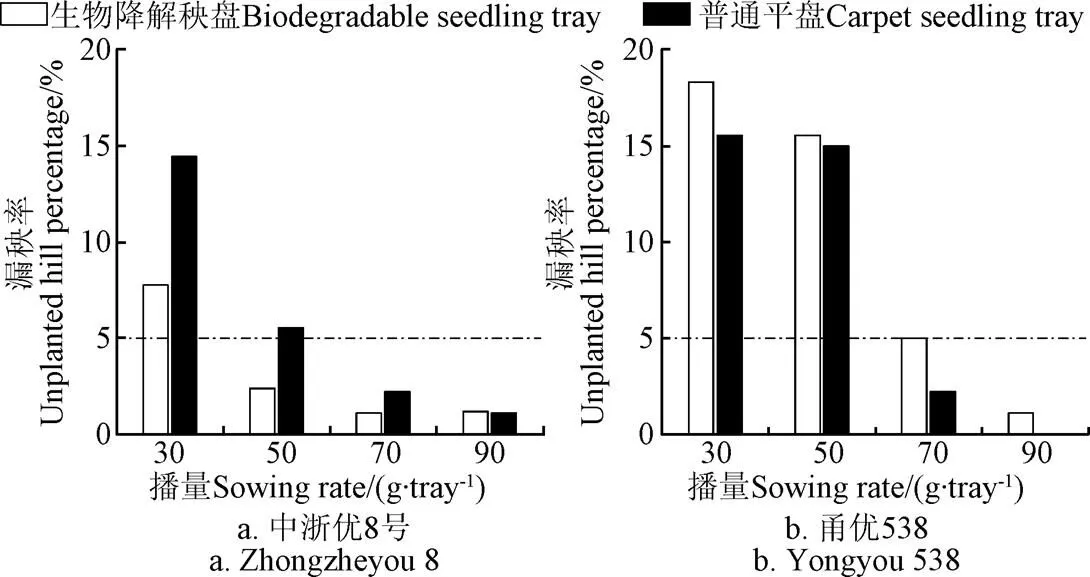
图3 不同秧盘和播量机插的漏秧率
2.4 生物降解秧盘机插对水稻产量及其构成因素的影响
由表4可知,2品种中生物降解秧盘机插平均产量均略高于普通平盘。生物降解秧盘机插的平均穗数小于普通平盘,而平均每穗粒数高于后者。体现在平均群体颖花量上,生物降解秧盘机插高于普通平盘。平均结实率和平均千粒质量则小于普通平盘,除中浙优8号中结实率差异不显著外(>0.05),其他差异显著(<0.05)。随播量增加,产量呈先升后降的趋势。基本苗和穗数均呈上升趋势,基本苗不同播量间差异显著,但穗数总体上差异不明显。中浙优8号中不同播量间每穗粒数差异不显著(>0.05),而甬优538中差异显著,以生物降解秧盘70 g/盘处理最高,达到每穗367.98粒。群体颖花量上,2品种均以生物降解秧盘70 g/盘处理最高,中浙优8号和甬优538分别达到49 059.76×104和68 486.07×104个/hm2。对群体颖花量与产量作相关性分析,相关系数为0.88,达到极显著水平。结实率和千粒重变化规律则不明显。秧盘与播量间互作极显著(<0.01),以生物降解秧盘70 g/盘处理产量最高,中浙优8号和甬优538分别达到了10.23和11.44 t/hm2。可见,生物降解秧盘机插的平均群体颖花量比普通平盘机插高,但结实率和千粒重低,最终表现为生物降解秧盘机插产量略高于普通平盘机插。稀播条件下,虽然水稻群体自我调节作用能在一定程度上弥补基本苗的不足,但穗数依然偏低,导致群体颖花量较少,穗粒结构不协调,限制了杂交稻产量潜力的发挥。
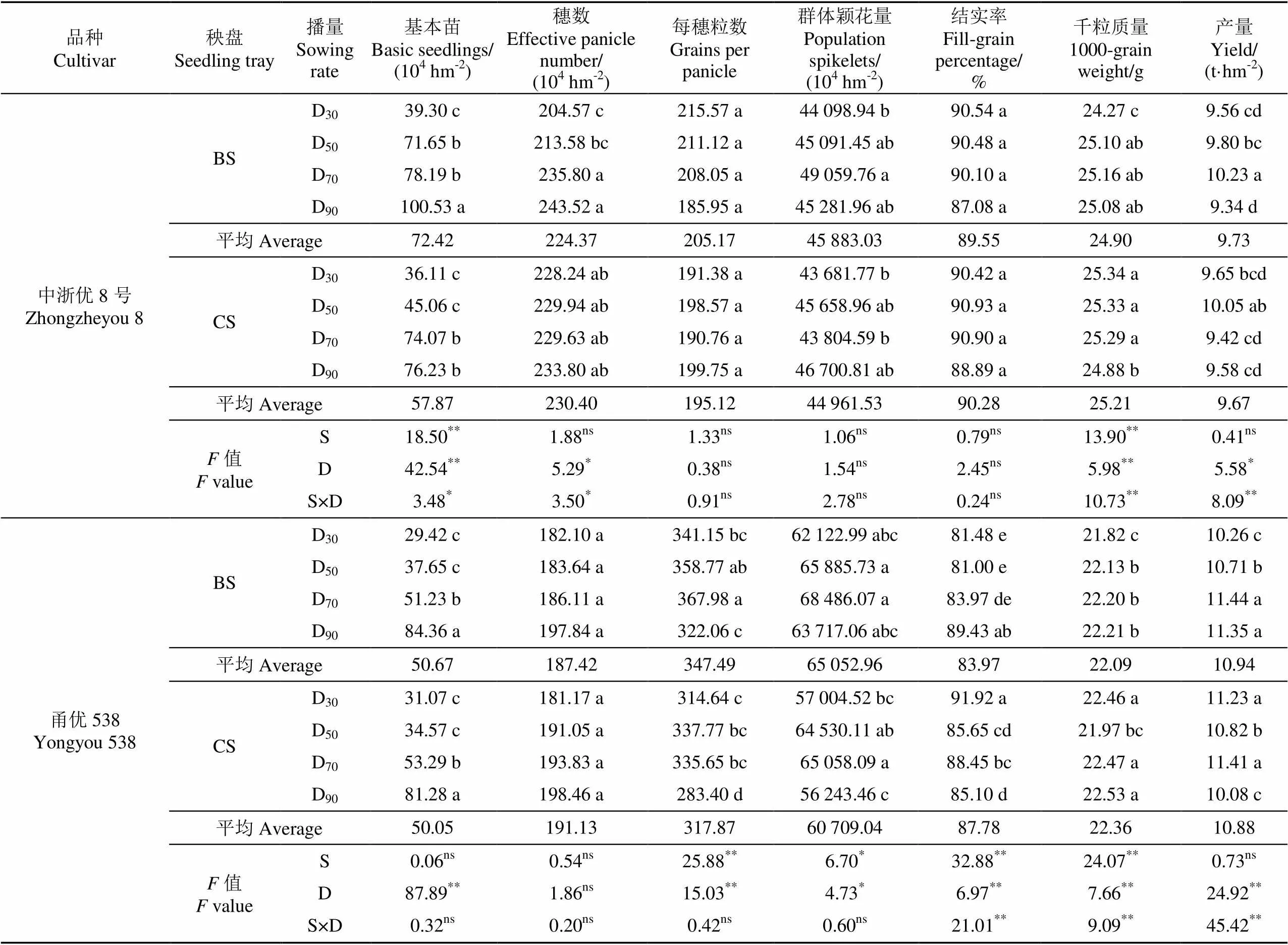
表4 不同秧盘和播量机插水稻的产量及其构成因素
3 讨 论
3.1 水稻生物降解秧盘机插适应性
机插秧由于盘根成毯的需要,播种密度极大,秧苗生长空间狭小,导致器官发育不充分,秧苗素质较差[7]。对杂交稻机插而言,充分利用其分蘖力强和大穗优势,就需少本稀植,育秧时降低播量,但低播量下就会出现秧块成毯差和漏秧率高等问题[9,12,15-16]。本研究使用生物降解秧盘育秧,实现带盘机插,播量不再成为制约秧块成毯的因素,稀播条件下能够满足机插对秧块结构性的要求。而普通平盘育秧依靠高播量盘根成毯,稀播条件下秧苗成毯差,几乎不能起秧。生物降解秧盘采用上毯下钵的设计,通过调节插秧机取秧量,可实现机插按钵精确取秧栽插。本研究发现中浙优8号使用生物降解秧盘育秧,其机插漏秧率明显低于使用普通平盘育秧,30 g/盘时生物降解秧盘的漏秧率比普通平盘低6.67个百分点。但稀播条件下,漏秧率仍普遍超过5%。因此,需通过精量匀播,提高秧苗成苗率和均匀度,适当增大插秧机取秧面积,将机插漏秧率控制在5%以下,以满足机插要求[7,13-14,18-19]。
3.2 水稻生物降解秧盘育秧秧苗的生长特点
利用生物降解秧盘带盘机插,使降低播量培育壮秧成为可能。众多研究表明,降低育秧播量可改善秧苗生长生态环境,提高秧苗素质,增强秧龄弹性,并提高秧苗栽后相对生长率[9,13,16-17,20-26]。本试验中,稀播可提高出苗率,综合优化秧苗形态,并能提高秧苗根系生物量,扩大营养吸收面积。稀播条件下生物降解秧盘的出苗率明显高于普通平盘,但秧苗形态两者并无显著差异。插秧机在机插过程中会对秧苗造成伤害,导致机插后秧苗会有一周左右的生长停滞[27-28]。生物降解秧盘所育秧苗的根系在钵碗中盘结,形成相对独立的钵苗,机插时按钵取秧栽插,对根系伤害较小,利于水稻栽后早生快发[29-30]。再者,生物降解秧盘所育秧苗的根系较普通平盘粗短、根白,说明其根系吸收营养物质的能力相对较强[9]。
3.3 水稻生物降解秧盘机插产量及适宜播量
播量不仅影响秧苗素质,还通过影响基本苗和漏秧率来影响水稻大田生长和产量[17]。本研究中,生物降解秧盘机插的平均群体颖花量高于普通平盘机插,但结实率和千粒重低,最终生物降解秧盘机插产量略高于普通平盘机插。在撒播条件下,30 g/盘处理的基本苗明显低于其他播量处理,虽然水稻群体自我调节作用能在一定程度上弥补基本苗的不足,但群体颖花量仍然偏少,导致产量较低,限制了杂交稻产量潜力的发挥[31-33]。相比之下,70 g/盘处理能够保证足够的基本苗,产量构成要素也较为合理,产量在所有处理中达到最高。播量再高时每穗粒数下降明显,产量反而有所下降。可见,杂交稻使用生物降解秧盘机插,播量不是越低越好,必须提高播种质量,实现精播匀播,协调好漏秧率和种植密度,以发挥稀播育壮秧和无损移栽的优势,创建高质量群体起点,实现高产稳产。
4 结 论
综合上述分析和讨论,本研究初步结论:1)生物降解秧盘带盘机插,盘根力均大于100 N,使稀播培育壮秧成为可能。2)使用生物降解秧盘育秧,可提高出苗率,所育秧苗根系短粗、根白,且根系相对独立,有利于减轻取秧和栽插过程中秧爪对秧苗根系的损伤。3)生物降解秧盘采用上毯下钵设计,调节插秧机取秧量可实现按钵精确机插,较普通平盘机插显著降低漏秧率。4)撒播条件下生物降解秧盘育秧以70 g/盘为宜,能够保证基本苗,实现高产稳产。如能实现精播匀播,协调好漏秧率和种植密度,可进一步减少育秧播量,降低水稻生产成本。因此,生物降解秧盘带盘机插可发挥稀播培育壮秧优势,提高机插质量,有助于杂交稻少本稀植、充分发挥增产潜力。
[1] 彭少兵. 转型时期杂交水稻的困境与出路[J]. 作物学报,2016,42(3):313-319. Peng Shaobing. Dilemma and way-out of hybrid rice during the transition period in China[J]. Acta Agronomic Sinica, 2016, 42(3): 313-319. (in Chinese with English abstract)
[2] Peng Shaobing, Tang Qiyuan, Zou Yingbin. Current status and challenges of rice production in China[J]. Plant Production Science, 2009, 12(1): 3-8.
[3] IRRI. Rice almanac, 4th edition[M]. Philippines: Internation Rice Research Institute, 2013.
[4] Zhang Liyang, Zhang Zhongxu, Li Quanying, et al. Mechanical automation of rice transplanting and key agronomic techniques[J]. Applied Mechanics & Materials, 2013, 345: 498-501.
[5] Xu Lijun, Yang Minli. Paddy rice production mechanization in China:A review[J]. Ama-Agricultural Mechanization in Asia Africa and Latin America, 2014, 45(4): 7-11.
[6] 白人朴. 关于水稻生产机械化技术路线选择的几个问题[J]. 中国农机化学报,2011(1):15-18.
Bai Renpu. Several issues on the route choice of mechanization of rice production technology[J]. Chinese Agricultural Mechanization, 2011(1): 15-18. (in Chinese with English abstract)
[7] 张洪程,龚金龙. 中国水稻种植机械化高产农艺研究现状及发展探讨[J]. 中国农业科学,2014,47(7):1273-1289.
Zhong Hongcheng, Gong Jinlong. Research status and development discussion on high-yielding agronomy of mechanized planting rice in China[J]. Scientia Agricultura Sinica, 2014, 47(7): 1273-1289. (in Chinese with English abstract)
[8] 张洪程,李杰,戴其根,等. 机插稻“标秧、精插、稳发、早搁、优中、强后”高产栽培精确定量关键技术[J]. 中国稻米,2010,16(5):1-6.
Zhang Hongcheng, Li Jie, Dai Qigen, et al. Raising standardized seedling, quantitative transplanting by machine, tillering stable, draining paddy field early, optimizing middle growth, strengthening late growth-precise and quantitative key technology for high-yielding cultivation with manual and mechanical transplantation[J]. China Rice, 2010, 16(5): 1-6. (in Chinese with English abstract)
[9] 李泽华,马旭,谢俊锋,等. 双季稻区杂交稻机插秧低播量精密育秧试验[J]. 农业工程学报,2014,30(6):17-27.
Li Zehua, Ma Xu, Xie Junfeng, et al. Experiment on precision seedling raising and mechanized transplanting of hybrid rice under low sowing rate in double cropping area[J]. Transactions of the Chinese Society of Agricultural Engineering (Transactions of the CSAE), 2014, 30(6): 17-27. (in Chinese with English abstract)
[10] 邓兴旺,王海洋,唐晓艳,等. 杂交水稻育种将迎来新时代[J]. 中国科学:生命科学,2013,43(10):864-868.
Deng Xingwang, Wang Haiyang, Tang Xiaoyan, et al. Hybrid rice breeding welcomes a new era of molecular crop design[J]. Scientia Sinica Vitae, 2013, 43(10): 864-868. (in Chinese with English abstract)
[11] 张军,王兴龙,石广跃,等. 不同机栽方式下杂交稻产量及其形成特征比较[J]. 农业工程学报,2015,31(10):84-91. Zhang Jun, Wang Xinglong, Shi Guangyue, et al. Yield and its formation of hybrid rice under different mechanical transplanted methods[J]. Transactions of the Chinese Society of Agricultural Engineering (Transactions of the CSAE), 2015, 31(10): 84-91. (in Chinese with English abstract)
[12] 彭长青,李世峰,卞新民,等. 机插水稻高产栽培关键技术的适宜值[J]. 应用生态学报,2006,17(9):1619-1623.
Peng Changqing, Li Shifeng, Bian Xinmin, et al. Appropriate parameters for high yielding cultivation of machine transplanted rice[J]. Chinese Journal of Applied Ecology, 2006, 17(9): 1619-1623. (in Chinese with English abstract)
[13] 胡剑锋,杨波,周伟,等. 播种方式和播种密度对杂交籼稻机插秧节本增效的研究[J]. 中国水稻科学,2017,31(1):81-90.
Hu Jianfeng, Yang Bo, Zhou Wei, et al. Effect of seeding method and density on the benefit of mechanical transplanting in indica hybrid rice[J]. Chinese Journal of Rice Science, 2017, 31(1): 81-90. (in Chinese with English abstract)
[14] 徐一成,朱德峰,赵匀,等. 超级稻精量条播与撒播育秧对秧苗素质及机插效果的影响[J]. 农业工程学报,2009,25(1):99-103.
Xu Yicheng, Zhu Defeng, Zhao Yun, et al. Effects of broadcast sowing and precision drilling of super rice seed on seedling quality and effectiveness of mechanized transplanting[J]. Transactions of the Chinese Society of Agricultural Engineering (Transactions of the CSAE), 2009, 25(1): 99-103. (in Chinese with English abstract)
[15] 姚雄,杨文钰,任万军. 育秧方式与播种量对水稻机插长龄秧苗的影响[J]. 农业工程学报,2009,25(6):152-157.
Yao Xiong, Yang Wenyu, Ren Wanjun. Effects of seedling raising methods and sowing rates on machine-transplanted long-age rice seedling[J]. Transactions of the Chinese Society of Agricultural Engineering (Transactions of the CSAE), 2009, 25(6): 152-157. (in Chinese with English abstract)
[16] 于林惠,丁艳锋,薛艳凤,等. 水稻机插秧田间育秧秧苗素质影响因素研究[J]. 农业工程学报,2006,22(3):73-78.
Yu Linhui, Ding Yanfeng, Xue Yanfeng, et al. Factors affacting rice seedling quality of mechanical transplanting rice[J]. Transactions of the Chinese Society of Agricultural Engineering (Transactions of the CSAE), 2006, 22(3): 73-78. (in Chinese with English abstract)
[17] 沈建辉,邵文娟,张祖建,等. 水稻机插中苗双膜育秧落谷密度对苗质和产量影响的研究[J]. 作物学报,2004,30(9):906-911.
Shen Jianhui, Shao Wenjuan, Zhang Zujian, et al. Effects of sowing density on quality of medium-seedling nursed with two-layer plastic film and grain yield in mechanical transplanting rice[J]. Acta Agronomica Sinica, 2004, 30(9): 906-911. (in Chinese with English abstract)
[18] 李木英,黄程宽,谭雪明,等. 不同机插株距和取秧面积对双季早稻产量的影响[J]. 江西农业大学学报,2015,37(6):947-954. Li Muying, Huang Chengkuan, Tan Xueming, et al. Impact of machine transplanting space and seedling-taken size on the yield of double season early rice[J]. Acta Agriculturae Universitatis Jiangxiensis, 2015, 37(6): 947-954. (in Chinese with English abstract)
[19] 罗汉亚,李吉,袁钊和,等. 杂交稻机插秧育秧播种密度与取秧面积耦合关系[J]. 农业工程学报,2009,25(7):98-102.
Luo Hanya, Li Ji, Yuan Zhaohe, et al. Coupling relationships of nursing seedling densities and finger sticking area by mechanized hybrid rice transplanter[J]. Transactions of the Chinese Society of Agricultural Engineering (Transactions of the CSAE), 2009, 25(7): 98-102. (in Chinese with English abstract)
[20] Toshihiko Nishio, Sadakichi Fujii. Studies on the physical characteristics of rice seedling: IV.The effects of some conditions in raising of seedling[J]. Japanese Journal of Crop Science, 1978, 47(1): 111-117.
[21] Ryouji Sasaki, Katsunori Gotoh. Characteristics of rooting and early growth of transplanted rice nursling seedlings with several plant ages in leaf number[J]. Japanese Journal of Crop Science, 1999, 68(2): 194-198.
[22] Naomichi Tanaka, Kin-ichi Nishikawa, Kenji Akita. Relation between characteristics and rooting activity of rice seedlings (Oryza sativa L.) with special reference to amylase activity[J]. Japanese Journal of Crop Science, 1990, 59(2): 334-339.
[23] 姚雄. 杂交中稻大苗机插植株生长特性与育秧技术研究[D]. 成都:四川农业大学,2010.
Yao Xiong. Research on the plant growth characteristics and seedling-raising techniques for machine-transplanted mid-season hybrid rice[D]. Chengdu: Sichuan Agricultural University, 2010. (in Chinese with English abstract)
[24] 刘义. 秧龄、移栽密度和播种密度对双季稻生长特性的影响[D]. 武汉:华中农业大学,2015.
Liu Yi. The effect of seedling age, transplanting density and seedling rate on the growth characteristics in double season rice [D]. Wuhan: Huazhong Agricultural University, 2015. (in Chinese with English abstract)
[25] 黄大山. 播期、播量和移栽密度对宁粳1号机插稻产量形成及氮素吸收的影响[D]. 扬州:扬州大学,2008.
Huang Dashang. Effects of sowing date, sowing rate and transplanting density on the yield formation and nitrogen absorption of mechanical transplanting rice Ning Jing 1 [D]. Yangzhou: Yangzhou University, 2008. (in Chinese with English abstract)
[26] Ryouji Sasaki. Characteristics and seedling establishment of rice nursling seedlings[J]. Jarq-Japan Agricultural Research Quarterly, 2004, 38(1): 7-13.
[27] Ikeda H, Kamoshita A, Manabe T. Genetic analysis of rooting ability of transplanted rice (Oryza sativa L.) under different water conditions[J]. Journal of Experimental Botany, 2007, 58(2): 309-318.
[28] Yoshinori Yamamoto, Kazumi Maeda, Kisaburo Hayashi. Studies on transplanting injury in rice plant: I. the effects of root cutting treatments on the early growth of rice seedlings after transplanting[J]. Japanese Journal of Crop Science, 1978, 47(1): 31-38.
[29] 陈惠哲,朱德峰,徐一成. 水稻钵形毯状秧苗机插技术及应用效果[J]. 中国稻米,2009,15(3):5-7.
Chen Huizhe, Zhu Defeng, Xu Yicheng. Mechanized planting technology of rice bowl-shaped blanket seedling and application effect[J]. China Rice, 2009, 15(3): 5-7. (in Chinese with English abstract)
[30] 张洪程,朱聪聪,霍中洋,等. 钵苗机插水稻产量形成优势及主要生理生态特点[J]. 农业工程学报,2013,29(21):50-59.
Zhang Hongcheng, Zhu Congcong, Huo Zhongyang, et al. Advantages of yield formation and main charicteristics of physiological and ecological in rice with nutrition bowl mechanical transplanting[J]. Transactions of the Chinese Society of Agricultural Engineering (Transactions of the CSAE), 2013, 29(21): 50-59. (in Chinese with English abstract)
[31] Yoshida H, Horie T, Shiraiwa T. A model explaining genotypic and environmental variation of rice spikelet number per unit area measured by cross-locational experiments in Asia[J]. Field Crops Research, 2006, 97(2/3): 337-343.
[32] 张洪程,吴桂成,吴文革,等. 水稻“精苗稳前、控蘖优中、大穗强后”超高产定量化栽培模式[J]. 中国农业科学,2010,43(13):2645-2660.
Zhang Hongcheng, Wu Guicheng, Wu Wenge, et al. The SOI model of quantitative cultivation of super-high yielding rice[J]. Scientia Aricultura Sinica, 2010, 43(13): 2645-2660. (in Chinese with English abstract)
[33] 张洪程,赵品恒,孙菊英,等. 机插杂交粳稻超高产形成群体特征[J]. 农业工程学报,2012,28(2):39-44.
Zhang Hongcheng, Zhao Pinheng, Sun Juying, et al. Population characteristics of super high yield formation of mechanical transplanted japonica hybrid rice[J]. Transactions of the Chinese Society of Agricultural Engineering (Transactions of the CSAE), 2012, 28(2): 39-44. (in Chinese with English abstract)
Effects of biodegradable seedling tray and sowing rate on seedling quality and yield of mechanical transplanting rice
Shi Hongzhi, Zhu Defeng, Zhang Yuping, Xiang Jing, Zhang Yikai, Zhu Conghua, Wu Hui, Chen Huizhe※
(,,310006)
Mechanical transplanting is the tendency of planting mechanization for most of rice regions in China. The sowing rate of nursing seedling is usually high (90-120 g/tray) for forming seedling carpet and reducing the unplanted hill percentage, which leads to weak seedlings, excessive basic seedlings in fields, and poor heterosis representations for hybrid rice. The biodegradable seedling tray is made with bioplastic - polylactic acid (PLA, a kind of material widely used) and designed as bowl-blanket shape and mechanical transplanting with seedling tray, which could provide a new way to realize mechanical transplanting of hybrid rice under thin sowing rate model. This experiment was conducted to evaluate the applicability of biodegradable seedling tray in thin sowing and mechanical transplanting. Zhongzheyou 8 (indica hybrid rice) and Yongyou 538 (indica-japonica hybrid rice) were used as materials. The carpet seedling tray was applied as control. Four sowing rates: 30, 50, 70 and 90 g/tray were adopted (the weight of dry seeds). The nineteen-days-old seedlings under different tray and sowing rate treatments were transplanted in the plot of 30 m2separately with 30 cm × 18 cm planting density. A fertilizer dose of 180:450:112.5 kg/hm2of N:P:K was applied in the form of urea, calcium superphosphate, and potassium chloride, respectively. The nitrogen fertilizer was applied at soil preparation, tillering stage and panicle initiation stage in a proportion of 5:3:2. Total phosphorus fertilizer was applied at soil preparation and total potassium fertilizer was applied at panicle initiation stage. Weeds, insects and diseases were intensively controlled during the whole growing season to avoid yield loss. The other managements were uniform with high-yield cultivation. In this experiment, the emergence rate of seed, morphological characteristic of shoot and root of seedlings, root entwining force, unplanted hill percentage of mechanical transplanting, the yield and its components were investigated. Results showed that, nursing seedling with biodegradable seedling tray had significant the emergence rate increase (<0.05), and the lower sowing rate, the higher the emergence rate compared with carpet seeding tray. The emergence rate of Zhongzheyou 8 in 30 g/tray treatment was higher by 20.57 percentagepoints than that of the carpet seedling tray. The seedlings roots in biodegradable seedling tray treatment were white, stubby, separate and coiled in bowls due to bowl-blanket design and the average root diameter was 8.63% greater than that of the carpet seedling tray (<0.05). In addition, the root entwining force of seedlings with biodegradable seedling tray was greater than 100 N in all sowing rates treatments, which met the demand of mechanical transplanting. Because of bowl-shaped precision transplanting with seedling tray, the unplanted hill percentage of Zhongzheyou 8 in 30 g/tray treatment declined by 6.67 percentagepointscompared with carpet seedling tray. Despite the fill-grain percentage and the 1 000-grain weight of biodegradable seedling tray treatment were lower (<0.05) than that of carpet seedling tray, but the population spikelets and yield were slightly higher. According to the performance of nursing seedlings, mechanical transplanting and yield, 70 g/tray was appropriate sowing date for biodegradable seedling tray. Our results suggested that biodegradable seedling tray transplanted with tray was beneficial for nursing strength seedlings under thin sowing model, improving mechanical transplanting quality and yield potentiality of hybrid rice.
crops; mechanization; seed; rice; mechanical transplanting; biodegradable seedling tray; seedling quality; yield
10.11975/j.issn.1002-6819.2017.24.004
S233.71
A
1002-6819(2017)-24-0027-08
2017-07-22
2017-12-06
国家自然科学基金(31501272)、浙江省公益技术研究农业项目(2015C32044)、2014RG004-2。
史鸿志,主要从事水稻种植机械化研究。 Email:1178244522@qq.com。
陈惠哲,研究员,博士,主要从事水稻种植机械化研究。 Email:chenhuizhe@163.com。
史鸿志,朱德峰,张玉屏,向 镜,张义凯,朱从桦,武 辉,陈惠哲. 生物降解秧盘及播种量对机插水稻秧苗素质及产量的影响[J]. 农业工程学报,2017,33(24):27-34. doi:10.11975/j.issn.1002-6819.2017.24.004 http://www.tcsae.org
Shi Hongzhi, Zhu Defeng, Zhang Yuping, Xiang Jing, Zhang Yikai, Zhu Conghua, Wu Hui, Chen Huizhe. Effects of biodegradable seedling tray and sowing rate on seedling quality and yield of mechanical transplanting rice[J]. Transactions of the Chinese Society of Agricultural Engineering (Transactions of the CSAE), 2017, 33(24): 27-34. (in Chinese with English abstract) doi:10.11975/j.issn.1002-6819.2017.24.004 http://www.tcsae.org
